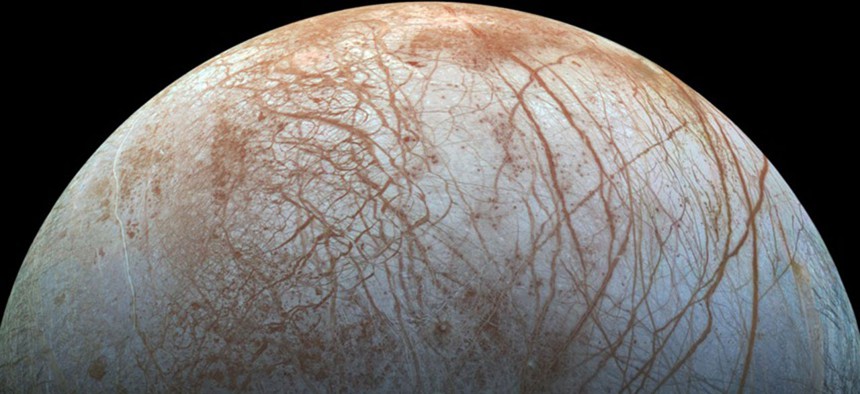The Solar System's Icy Secret Keeper
Scientists used archival data to search for signs of an ocean beneath Europa, a moon of Jupiter.
In 2003, a NASA spacecraft plunged into the swirling atmosphere of Jupiter and vaporized. Galileo, named for the astronomer who discovered the planet’s biggest moons, had spent more nearly eight years in orbit, collecting data about the Jovian environment and relaying it back to Earth.
“We learned mind-boggling things,” said Claudia Alexander, the mission’s project manager, after the probe sent its final transmissions home.
Fifteen years later, we’re still learning from the spacecraft.
Astronomers recently reanalyzed some data from the Galileo mission and found evidence of a plume on Europa, an icy moon of Jupiter. On Europa and other icy moons, plumes are jets of particles, likely water vapor, that burst through cracks in the surface. Plumes themselves are evidence—of the ocean beneath the surface, which could host microbial life.
Astronomers had previously seen some signs of plumes erupting from the surface of Europa. They were captured in images taken between 2012 and 2016 by the the Hubble Space Telescope orbiting Earth. But this finding marks the first time they’ve determined the presence of a plume using measurements taken near Europa. Their research was published Monday in Nature Astronomy.
Scientists have long suspected Europa has an ocean, and could even host the kinds of hydrothermal reactions that spawn bustling ecosystems in the depths of Earth’s oceans. The presence of plumes suggests some of this ocean is being spewed out into the space around Europa—which is exactly what scientists want.
In the next decade or so, two spacecraft, one from NASA and one from the European Space Agency, are supposed to arrive in the Jovian system. Like the Galileo spacecraft, they’ll swoop toward Europa, ingest any particles they encounter, and analyze them. With enough luck, they could fly near or through one of these plumes. Through these missions, scientists could learn even more mind-boggling things about the composition of Europa’s subsurface ocean, including whether it contains the chemical compounds that, under the right conditions, can give rise to life.
But first, let’s return to Galileo, as Xianzhe Jia, a planetary scientist at the University of Michigan, and his colleagues did for their research. Jia says he got the idea to reexamine Galileo data after listening to Melissa McGrath talk at a meeting for the Europa Clipper, the NASA mission set to launch to the moon in the 2020s. Both are working on instruments for the mission. A plume Hubble had captured twice, in 2014 and 2016, was located near Europa’s equator. And Galileo made some strange detections during a flyby in 1997, also near the equator. “That really caught our eye,” Jia says. Scientists didn’t know to look for plumes back then. Jia wondered, what if plumes were responsible for those detections?
Jia and his colleagues had already spent several years working on computer simulations of the environment of Europa, so they constructed a scenario based on the Galileo measurements. During a very close approach to Europa, at just about 125 miles above the surface, Galileo’s instruments detected changes in the moon’s magnetic field and in surrounding plasma, or ionized gas. Jia and his team inserted a plume into the simulation that resembled the one Hubble had seen, and found that its presence explained the changes in Europa’s magnetic field and nearby plasma.
When particles are ejected from Europa’s surface, many are neutral, Jia says. Once they’re in space, some of them become charged, thanks to radiation from the sun and the winds of the Jovian system. These newly charged particles perturb the magnetic field and bend it. The new population contributes to the surrounding plasma, increasing its overall density.
The research provides more evidence that there are, indeed, plumes on Europa, a theory that remains debated. The Hubble images are convincing, for the most part, but they are less convincing, for example, than images of Enceladus, a moon of Saturn, and another icy world with a suspected ocean lurking beneath the surface. Those pictures, taken by NASA’s Cassini before the mission ended last year, captured several jets of particles bursting from the moon’s surface like searchlights in darkness.
Europa has been better at keeping secrets than Enceladus, says Elizabeth Turtle, a planetary scientist at the Applied Physics Laboratory at Johns Hopkins University and the lead investigator on the Europa Clipper’s imaging team. “We don’t have the level of data that we have for Enceladus,” Turtle says. “The plumes there were so much easier to detect.”
In situ observations, from the space around Europa, will provide the most persuasive evidence, and research like Jia’s will help scientists plan where to send their spacecraft.
The Clipper mission will spend two years orbiting Jupiter and making at least 40 close flybys of Europa, surveilling different parts of the moon at each pass. The spacecraft doesn’t actually need to fly right through plumes to study the particles they unleash. “If the plume’s big enough, it’ll go global,” says Hunter Waite, a planetary scientist at the Southwest Research Institute and the lead on one of the mission’s instruments. Europa’s gravity will tug some escaped particles back to the surface, where they will bounce and scatter. Clipper’s instruments, Waite says, will be sensitive enough to detect them after the plume has subsided.
Scientists have already stretched the Hubble’s capabilities as far as they will go to capture a handful of small plumes. It’s possible that this latest discovery is one of the last pieces of evidence scientists will have of Europan plumes until the robotic missions arrive and pry the icy moon from its secrets.
“I think we’re going to be stuck until we get there,” Waite says.
NEXT STORY: NASA Is Going Back to Mars, And It's Going Deep




